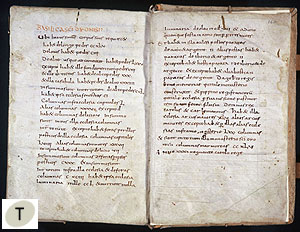- Home
- The town and the abbey
- From the royal abbey to the castellum
- The royal abbey
- A description of the basilica in 799
The description of the basilica in the Reichenau manuscript.
© Badische Landesbibliothek Karlsruhe.
The library at Karlsruhe in Germany contains a manuscript that was sent by the monks of Saint-Denis around 830 to their colleagues at Reichenau on Lake Constance. The manuscript contains a copy of a description of the basilica in Saint-Denis that was composed in 799, "in the thirty-first year of the reign of King Charles" (Charlemagne, 768-814). The text appears at the end of a Life of Saint Martin, which concludes with the description of the famous basilica at Tours. The description of Saint-Denis is copied from this, but plays up the numerical data (Saint-Denis is 245 feet long, while Saint-Martin is only 160 feet long, Saint-Denis has 101 windows, Saint-Martin has 55). We may thus consider this text to be for propaganda purposes, and it is a vain exercise to correlate this literary description, which appears to be quite precise, with the material remains of the structure uncovered by the American archaeologist Sumner McKnight Crosby.
Nevertheless, the document offers authentic testimony as to the church's furnishings. In particular, it emphasizes the distinction between the four great outside doors, which were adorned in gold and silver, and silver and ivory. In 1144, the abbot Suger wrote of the existence of one of these doors decorated in ivory, which led to the cloister.
The text states that Charlemagne and his brother Carloman built this structure, which was dedicated to the memory of their father Pepin. The reconstruction work would thus have begun after the death of Pepin in 768, and prior to that of Carloman in 771. On 24 February 775, the abbot Fulrad consecrated the reconstructed church in the presence of Charlemagne.

